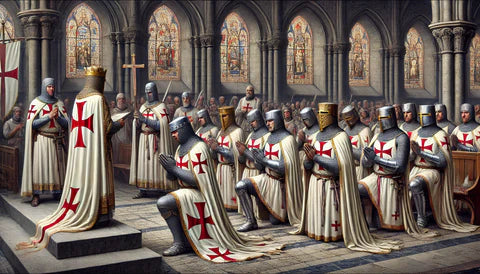The Templar Legacy: How the Order Shaped Europe
The Knights Templar, a medieval Christian military order founded in the early 12th century, left an indelible mark on Europe. Known for their distinctive white mantles adorned with a red cross, the Templars were not only warriors in the Crusades but also pioneers in finance, architecture, and European politics. Their influence extended far beyond the battlefield, and their legacy continues to intrigue historians, scholars, and the public alike.
The Rise of the Knights Templar
The Knights Templar were established around 1119 by a small group of knights led by Hugues de Payens. Their primary mission was to protect Christian pilgrims traveling to the Holy Land. Recognized by the Catholic Church and supported by influential figures such as St. Bernard of Clairvaux, the Templars quickly grew in power and numbers.
By the mid-12th century, the Templars had become one of the most formidable military orders in Christendom. Their role in the Crusades, particularly in battles such as the Siege of Acre and the Battle of Montgisard, solidified their reputation as elite warriors. However, their impact on Europe was not limited to their military exploits.
Pioneers of Medieval Finance
One of the most significant contributions of the Knights Templar was their role in the development of medieval finance. As their wealth and influence grew, the Templars began to offer financial services to pilgrims and European monarchs. They established a network of preceptories (regional administrative centers) across Europe, which served as a foundation for their financial operations.
The Templars were among the first to develop a system of banking that allowed for the safe transfer of money across vast distances. Pilgrims could deposit funds in one Templar preceptory and withdraw them in another, reducing the risk of theft during their journey to the Holy Land. This early form of banking laid the groundwork for modern financial systems.
Moreover, the Templars lent money to European kings and nobility, often acting as a trusted source of credit. Their financial acumen and vast resources made them indispensable to the European economy, allowing them to exert significant influence over political and economic affairs.

Architectural Innovation and Legacy
The Templars were also responsible for some of the most iconic architectural structures of the medieval period. Their churches and fortresses were not only places of worship and defense but also symbols of their power and influence. The Templars were heavily influenced by the architectural styles of the Byzantine and Islamic worlds, which they encountered during their time in the Holy Land.
One of the most famous Templar structures is the Temple Church in London, built in the 12th century. Its distinctive circular nave was inspired by the Church of the Holy Sepulchre in Jerusalem, reflecting the Templars' connection to the Holy Land. The church remains a testament to the Templars' architectural legacy and their ability to blend different cultural influences into their designs.
The Templars also constructed formidable fortresses throughout Europe and the Middle East, including the Krak des Chevaliers in Syria and the Château de Gisors in France. These structures were engineering marvels of their time, designed to withstand sieges and protect the order's wealth and personnel.
Political Influence and Power
The Templars' rise to power was not solely due to their military and financial capabilities; their political influence also played a crucial role. The order maintained close relationships with European monarchs and the Papacy, often serving as advisors and diplomats. Their loyalty to the Church and their role in the Crusades earned them special privileges, including exemption from local laws and taxes.
However, the Templars' immense power and wealth eventually led to their downfall. King Philip IV of France, heavily indebted to the Templars, saw them as a threat to his authority. In 1307, he ordered the arrest of all Templars in France, accusing them of heresy, blasphemy, and other crimes. Under torture, many Templars confessed to these charges, leading to the dissolution of the order by Pope Clement V in 1312.
The sudden fall of the Templars sent shockwaves throughout Europe. Their properties were seized, and many of their members were executed or imprisoned. Despite this, the Templars' influence persisted, with many of their financial and architectural innovations continuing to shape European society.

The Templar Legacy in European Culture
The legacy of the Knights Templar has endured for centuries, evolving into a mix of historical fact, legend, and conspiracy theory. The order's sudden downfall, combined with the secrecy surrounding their rituals and operations, has fueled speculation and intrigue.
In literature and popular culture, the Templars have been depicted in various ways, from noble knights to shadowy figures guarding hidden treasures. The mythos surrounding the Templars has inspired countless books, films, and video games, cementing their place in the popular imagination.
Yet beyond the myths, the Templars' real contributions to Europe remain significant. Their innovations in finance, architecture, and governance helped shape the development of European society during the medieval period and beyond. The Templars' story is not just one of crusades and conquests but also of cultural exchange, economic development, and architectural achievement.
Conclusion
The Knights Templar were more than just a military order; they were a driving force in shaping medieval Europe. Their contributions to finance, architecture, and politics left a lasting legacy that continues to be felt today. While the Templars' dramatic rise and fall have captured the imagination of many, it is their enduring impact on European history that truly defines their legacy.
As we continue to explore the Templars' influence, we gain a deeper understanding of how this enigmatic order helped shape the course of European history. The Templar legacy is a testament to the complex interplay of religion, politics, and economics in the medieval world, offering valuable insights into the forces that have shaped our modern society.









